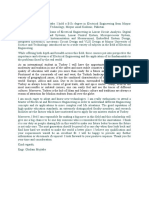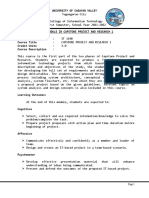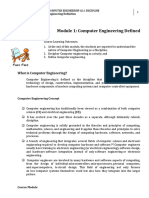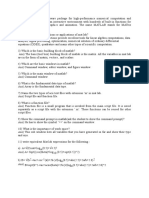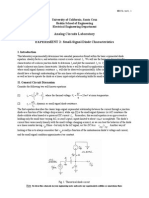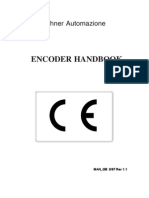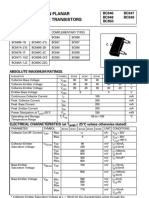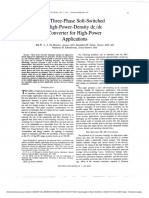Lab3 BJT Current Mirrors
Lab3 BJT Current Mirrors
Uploaded by
aublysodonCopyright:
Available Formats
Lab3 BJT Current Mirrors
Lab3 BJT Current Mirrors
Uploaded by
aublysodonOriginal Description:
Original Title
Copyright
Available Formats
Share this document
Did you find this document useful?
Is this content inappropriate?
Copyright:
Available Formats
Lab3 BJT Current Mirrors
Lab3 BJT Current Mirrors
Uploaded by
aublysodonCopyright:
Available Formats
EE171L rev2
University of California, Santa Cruz
Baskin School of Engineering
Electrical Engineering Department
Analog Circuits Laboratory
EXPERIMENT 3: BJT CURRENT SOURCES
1. DESCRIPTION AND OBJECTIVES
This laboratory investigates several basic bipolar junction NPN transistor current mirror circuits
that implement current sources universally employed in integrated circuits to provide reference
bias currents. These include the basic BJT mirror, base current compensated current mirror and
the Wilson Mirror. Attention will be focused on understanding each of these circuits basic
features with respect to how well they implement an ideal current source. You should have a
deeper understanding of the differences between ideal voltage and current sources, as well as an
appreciation for the non-ideal characteristics of practical current sources.
2. GENERAL DISCUSSION
We will be using a type CA3086 (or equiv.) NPN transistor array. This 14-pin DIP device
contains five electrically matched BJTs: two are configured as a differential pair, while the
remaining three are uncommitted single transistors. The chip is not static sensitive. However,
when using it, be certain the common monolithic substrate, pin-13, is always at the lowest DC
circuit potential. In this lab just be sure its grounded! Refer to the attached data sheet for pin
definitions and other useful information about this device.
EE171L rev2
3. CIRCUIT-1: BASIC BJT CURRENT MIRROR
Construct the circuit shown in fig. 1. Be sure to accurately measure (with the most significant
figures possible) and
. Also, verify that your 10k pot is really 10k before using it!
Figure 1. Basic BJT Current Mirror.
Note: Re-draw this schematic in your engineering notes and make any experimental scribbles or annotations there.
sets
to about 1 mA.
and the 10k potentiometer constitute the load on Q2. This load
configuration will make it easier to quickly obtain necessary experimental measurements. You
are to measure
(current through R1),
, the mirrored current ratio , and determine the
Norton and Thevenin equivalent circuits for this mirror.
From your data, produce two accurate and well-drawn plots as follows:
Graph 1:
vs.
for the full range possible for
(10k pot over its full range). Calculate
the slope from a least-squares regression line analysis and use it to estimate . Indicate which
data pairs you used and where the voltage compliance range is (use data sheets to estimate where
it ends).
Graph 2:
changes.
vs.
for the same range of
as graph 1. Explain why the current ratio
EE171L rev2
Experimental Procedure:
1. Adjust the DC power source for 15 [V] before connecting it to your circuit. This is nominal;
get it close and measure it precisely. Be sure the substrate, pin 13, is grounded. Although
these circuits are simple, put the pin numbers on your experimental schematics to help you
keep track of what has been done.
2. Keep a rough sketch of graph 1 in your engineering notes as you proceed. This will give you
enough perspective to judge how close and how many data measurements are needed.
3. To help you collect and calculate the right quantities, consider beginning with the following
table:
VR1
VCE2
VCC2
VR2
IC2
Take all measurements with as many significant figures as possible. Your calculations should
be expressed with proper precision.
4. Dont try and measure current using the current feature on the lab DVM. Current
measurements require breaking the circuit and inserting some amount of sampling resistance
(contained inside the DVM) that depends on what current scale is being used (lower currents
require greater resistance). This will cause unavoidable errors here. Therefore, all currents
should be calculated from an appropriate measured voltage using Ohms law (be sure and log
the voltage).
and
must be found in this manner and will require floating voltage
measurements.
EE171L rev2
4. CIRCUIT-2: Basic Current Mirror with Base Current Compensation
Modify circuit 1 by adding the base current compensation transistor Q3 as shown in fig. 2 below.
Repeat the same procedure experimental procedure you followed for the first circuit and report
with the same data and graphs.
Figure 2. Basic BJT Base Compensated Mirror.
Note: Re-draw this schematic in your engineering notes and make any experimental scribbles or annotations there.
EE171L rev2
5. CIRCUIT-3: Wilson Current Mirror
Modify circuit 2 into a Wilson Mirror as shown below in fig. 3. Repeat the same procedure
experimental procedure you followed for the first circuit. Also report with the same data and
graphs.
Figure 3. Wilson Current Mirror.
Note: Re-draw this schematic in your engineering notes and make any experimental scribbles or annotations there.
6. QUESTIONS
1. Carefully compare the results for these three circuits and discuss how well each one
implements an ideal current source. Try and rank them in terms of which is the best to the
worst in this regard.
2. If the transistors were not constructed on the same monolithic substrate, how would this affect
the performance of each circuit?
3. Calculate the small-signal output resistance from data sheets and compare to the results you
experimentally obtained for
.
You might also like
- Ee 231 - Electric Circuits 1Document31 pagesEe 231 - Electric Circuits 1Kene LawNo ratings yet
- Ee31 Syllabus - Cpe 4a - c1Document5 pagesEe31 Syllabus - Cpe 4a - c1Neil CzsNo ratings yet
- Introduction To Electrical EngineeringDocument221 pagesIntroduction To Electrical EngineeringMarwin DacallosNo ratings yet
- Btech. 1st Year New Syllabus FINAL 2008 BPUTDocument22 pagesBtech. 1st Year New Syllabus FINAL 2008 BPUTSushree MishraNo ratings yet
- Technology and Livelihood Education: Computer System Servicing Quarter 1-Module 4Document42 pagesTechnology and Livelihood Education: Computer System Servicing Quarter 1-Module 4Renny Romero LuzadaNo ratings yet
- EE LAWS SyllabusDocument7 pagesEE LAWS SyllabusEE FilesReviewNo ratings yet
- Introductory Concepts of Circuit Topology and DC ExcitationsDocument34 pagesIntroductory Concepts of Circuit Topology and DC ExcitationsFrance Mae CamogaoNo ratings yet
- EE 413-Engg ElectromagneticsDocument2 pagesEE 413-Engg ElectromagneticsVan GonzalesNo ratings yet
- Single Phase Full Wave Voltage Multiplier PDFDocument3 pagesSingle Phase Full Wave Voltage Multiplier PDFJoshua Amiel javines0% (1)
- EEC245 Electrical Installation of BuildingDocument1 pageEEC245 Electrical Installation of BuildingSHAMSUDEEN muhammedNo ratings yet
- Lab-Manual: 8EE06 Electrical Drive & Control LabDocument76 pagesLab-Manual: 8EE06 Electrical Drive & Control Labprachi 18No ratings yet
- Practicing The ECE Profession PDFDocument6 pagesPracticing The ECE Profession PDFRenesiy Marco NovillaNo ratings yet
- Pledge of ECEDocument29 pagesPledge of ECEJehnen Baltazar0% (1)
- Numerical Methods SyllabusDocument3 pagesNumerical Methods SyllabusRodrigoNoaNo ratings yet
- DECENA - IBE - Laboratory Exercise No 6Document16 pagesDECENA - IBE - Laboratory Exercise No 6John Rhey IbeNo ratings yet
- No. of Theory Courses: 5 Total Contact Hours: (15+7.5) 22.5 No. of Lab/Sessional Courses: 3 Total Credit: 18.75Document27 pagesNo. of Theory Courses: 5 Total Contact Hours: (15+7.5) 22.5 No. of Lab/Sessional Courses: 3 Total Credit: 18.75nspNo ratings yet
- Motivation LetterDocument1 pageMotivation LetterGhulam MujtabaNo ratings yet
- COURSE - SYLLABUS - Physics PhilippinesDocument11 pagesCOURSE - SYLLABUS - Physics PhilippinesGleanna NiedoNo ratings yet
- Ece 529 Industrial ElectronicsDocument4 pagesEce 529 Industrial ElectronicsRobin AlbisNo ratings yet
- Electrical Engineering PDFDocument8 pagesElectrical Engineering PDFHans Christian MacasaNo ratings yet
- CMO 24 s2008 Annex IVB List of LABORATORY Requirements For ECEDocument31 pagesCMO 24 s2008 Annex IVB List of LABORATORY Requirements For ECEcathyNo ratings yet
- University of Cagayan ValleyDocument5 pagesUniversity of Cagayan ValleyRandy TabaogNo ratings yet
- W1 Module 1 Computer Engineering DefinedDocument2 pagesW1 Module 1 Computer Engineering DefinedMeira LacumboNo ratings yet
- 2 Digital Principles Assignment Outcome 1 2 3 4Document7 pages2 Digital Principles Assignment Outcome 1 2 3 4Nada Mostafa MahmoudNo ratings yet
- Lecture 4 - Current Density, Conductors and CapacitanceDocument34 pagesLecture 4 - Current Density, Conductors and CapacitanceHannahmhel MuanaNo ratings yet
- Fourier-Analysis CE273Document41 pagesFourier-Analysis CE273Luyun GE Mark AnjoNo ratings yet
- B.tech Mechanical EngineeringDocument74 pagesB.tech Mechanical Engineeringsidd15042000No ratings yet
- EEE1001 - ELECTRIC-CIRCUITS-AND-SYSTEMS - LTP - 1.3 - 53 - EEE1001 - Electric Circuits and Systems - LTP - 4 - V1.3Document2 pagesEEE1001 - ELECTRIC-CIRCUITS-AND-SYSTEMS - LTP - 1.3 - 53 - EEE1001 - Electric Circuits and Systems - LTP - 4 - V1.3devmewada2505No ratings yet
- What Is MatlabDocument3 pagesWhat Is Matlabraghgk2012No ratings yet
- EEN 350 Chapter 2 Selected ProblemsDocument12 pagesEEN 350 Chapter 2 Selected ProblemsMario ArjaNo ratings yet
- PPP Areas I - XDocument151 pagesPPP Areas I - XCleofe CaidicNo ratings yet
- EE2022 Electrical Energy Systems: Lecture 17: Per Unit Analysis - Three Phase 21-03-2013Document44 pagesEE2022 Electrical Energy Systems: Lecture 17: Per Unit Analysis - Three Phase 21-03-2013Hamza AkçayNo ratings yet
- April 2019 R. E. E. Licensure Examination: Seq. NODocument24 pagesApril 2019 R. E. E. Licensure Examination: Seq. NOPRC Board100% (1)
- LCD - Introduction DefinitionDocument19 pagesLCD - Introduction DefinitionManjeet Kumar100% (1)
- An Introduction To Optimization: - Classification and Case StudyDocument18 pagesAn Introduction To Optimization: - Classification and Case StudyRogzJrBernzNo ratings yet
- Question Excerpt From RA 9292Document5 pagesQuestion Excerpt From RA 9292Bemark Emille IgnacioNo ratings yet
- CpE Curriculum 2013 2014 2013 07 01Document1 pageCpE Curriculum 2013 2014 2013 07 01rodrir327No ratings yet
- Cad NotesDocument44 pagesCad NotesChandan M R GowdaNo ratings yet
- TR - Elec Inst and Maint NC IIIDocument84 pagesTR - Elec Inst and Maint NC IIIDick Anthony MabaoNo ratings yet
- Ee114-1 Course SyllabusDocument6 pagesEe114-1 Course SyllabusDean AcklesNo ratings yet
- Performance of Schools ECE Board ExamDocument15 pagesPerformance of Schools ECE Board ExamTheSummitExpress100% (1)
- Assignment in Electrical Standards and PracticesDocument4 pagesAssignment in Electrical Standards and PracticesJade Danielle Enmoceno FortezaNo ratings yet
- Ee 417 - SyllabusDocument3 pagesEe 417 - SyllabusRowel Sumang FacunlaNo ratings yet
- Smart GridDocument30 pagesSmart GridkumarchaturvedulaNo ratings yet
- Basic ElectronicsDocument47 pagesBasic ElectronicsPolyn LopezNo ratings yet
- EE2022 Electrical Energy Systems: Lecture 13: Electric Power Transmission - Transmission Line Modeling 07/03/2013Document50 pagesEE2022 Electrical Energy Systems: Lecture 13: Electric Power Transmission - Transmission Line Modeling 07/03/2013Nemitha LakshanNo ratings yet
- Republic Act No. 5734Document4 pagesRepublic Act No. 5734Moomin OcampoNo ratings yet
- Radar Progress ReportDocument14 pagesRadar Progress ReportAsif ShaikhNo ratings yet
- Practical Task 2Document15 pagesPractical Task 2Kosigar Chelladorai100% (1)
- Semister Project Proposal FinalDocument10 pagesSemister Project Proposal FinalMuket Agmas100% (2)
- Unbalanced Three Phase SystemsDocument3 pagesUnbalanced Three Phase SystemsnpavankNo ratings yet
- Assessment and Redesign of The Electrical SystemDocument21 pagesAssessment and Redesign of The Electrical SystemCyriel HalasanNo ratings yet
- Electrical Measurements and Fault DiagnosisDocument174 pagesElectrical Measurements and Fault Diagnosisjosphat mbathaNo ratings yet
- Embedded Systems Unit I Part A (2 Marks)Document47 pagesEmbedded Systems Unit I Part A (2 Marks)Vijaya KumarNo ratings yet
- Industrial Electronics Lecture Notes 01 Orientation and Introduction PDFDocument7 pagesIndustrial Electronics Lecture Notes 01 Orientation and Introduction PDFSheehan Kayne De CardoNo ratings yet
- Basic Electrical Engineering SyllabusDocument5 pagesBasic Electrical Engineering SyllabusCatherine Salvador0% (1)
- Hyd & Pneumatics LabDocument6 pagesHyd & Pneumatics LabPepe AkashNo ratings yet
- Electrical Circuits 1 Lecture PrelimsDocument9 pagesElectrical Circuits 1 Lecture PrelimsGhe PataniNo ratings yet
- Chapter 1 - Database SystemsDocument34 pagesChapter 1 - Database SystemsDaniel BirhanuNo ratings yet
- Lab7 BJTDocument3 pagesLab7 BJTGustavo MarquesNo ratings yet
- Lab2 Small Signal DiodeDocument3 pagesLab2 Small Signal DiodePrincess Roxas CristobalNo ratings yet
- Experiment-No.8_DC-and-AC-Analysis-of-BJT-Using-LT-Spice (1)Document4 pagesExperiment-No.8_DC-and-AC-Analysis-of-BJT-Using-LT-Spice (1)fizzythelizzy456No ratings yet
- Ec 262 Pspice ManualDocument69 pagesEc 262 Pspice ManualRama KrishnaNo ratings yet
- EEE SUST Syllabus Session 2011-12Document31 pagesEEE SUST Syllabus Session 2011-12Shahadat Hussain ParvezNo ratings yet
- 2n3906 DatasheetDocument3 pages2n3906 DatasheetZain AliNo ratings yet
- 2N5551 NPN Transistor Complementary PNP, ReplacemDocument1 page2N5551 NPN Transistor Complementary PNP, ReplacemKaenge LuckyNo ratings yet
- MAN - GB Hohner Automazione ENCODER HANDBOOKDocument15 pagesMAN - GB Hohner Automazione ENCODER HANDBOOKhiloactive100% (2)
- Takex F70a&f70Document6 pagesTakex F70a&f70leoho320No ratings yet
- ST2001HI: High Voltage Fast-Switching NPN Power TransistorDocument6 pagesST2001HI: High Voltage Fast-Switching NPN Power Transistorgilberto gutierrezNo ratings yet
- Yamaha AX 592 Service ManualDocument75 pagesYamaha AX 592 Service ManualArturo ArmuellesNo ratings yet
- PPDCDocument18 pagesPPDCKarl Angelo R. Dela CruzNo ratings yet
- ACDCModuleUsersGuide PDFDocument366 pagesACDCModuleUsersGuide PDFRahman EjazNo ratings yet
- BC178Document6 pagesBC178segalignoNo ratings yet
- Sot23 NPN Silicon Planar General Purpose Transistors: BC846 BC847 BC848 BC849 BC850Document4 pagesSot23 NPN Silicon Planar General Purpose Transistors: BC846 BC847 BC848 BC849 BC850Thaynar BarbosaNo ratings yet
- EE203 Analog Electronic Circuits PDFDocument3 pagesEE203 Analog Electronic Circuits PDFlekshmit2001No ratings yet
- Module 04 Practice MCQ Part 01: # A) To Protect It From ACDocument15 pagesModule 04 Practice MCQ Part 01: # A) To Protect It From ACPrem MauryaNo ratings yet
- Safety Light CurtainDocument16 pagesSafety Light CurtainEng Abu ahmadNo ratings yet
- DAGA Lab8Document23 pagesDAGA Lab8Kristan Oneal DagaNo ratings yet
- Laporan Praktikum Elektronika Dasar 1 Transistor Sebagai Saklar Dan PenguatDocument34 pagesLaporan Praktikum Elektronika Dasar 1 Transistor Sebagai Saklar Dan PenguatassaNo ratings yet
- Unisonic Technologies Co., LTD: Low Voltage High Current Small Signal NPN TransistorDocument4 pagesUnisonic Technologies Co., LTD: Low Voltage High Current Small Signal NPN TransistorproctepNo ratings yet
- SSC JeDocument2 pagesSSC JeHemant ModiNo ratings yet
- A Three-Phase Soft-Switched High-power-Density DC DC Converter For High-Power ApplicationsDocument11 pagesA Three-Phase Soft-Switched High-power-Density DC DC Converter For High-Power ApplicationsKenil BrahmbhattNo ratings yet
- Physics Investigatory Project Common Base TransistorDocument12 pagesPhysics Investigatory Project Common Base TransistorMeena SinghNo ratings yet
- Instituite of Technollogy: ComputerDocument47 pagesInstituite of Technollogy: ComputerFìrœ Lōv MånNo ratings yet
- FP5043Document7 pagesFP5043Parag RekhiNo ratings yet
- Power Amplifiers:: γ= ac output power dc input power x 100Document8 pagesPower Amplifiers:: γ= ac output power dc input power x 100Delphin ShibinNo ratings yet
- Unmatched Protection Safety Light Curtain PDFDocument36 pagesUnmatched Protection Safety Light Curtain PDFiijnnnllkkjj100% (1)
- BXE Practical Journal (Experiment No. 1 To 8) - 1Document55 pagesBXE Practical Journal (Experiment No. 1 To 8) - 1kakashi hatake100% (1)
- Characteristics of ThyristorDocument75 pagesCharacteristics of Thyristoryogusmilu100% (1)
- Mini Project Report On Missing Pulse DetectorDocument13 pagesMini Project Report On Missing Pulse DetectorMohammad Fahad100% (1)
















